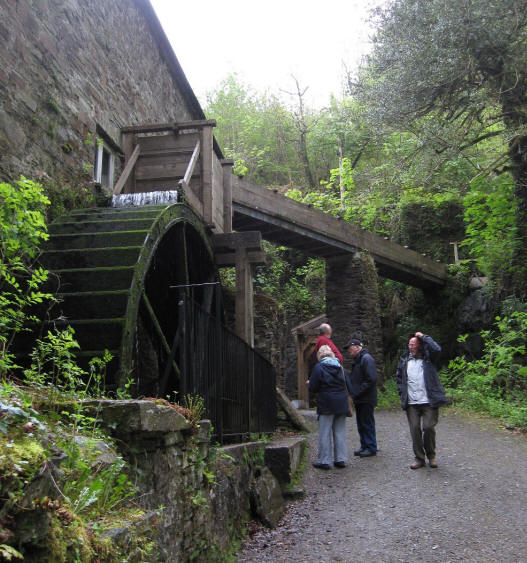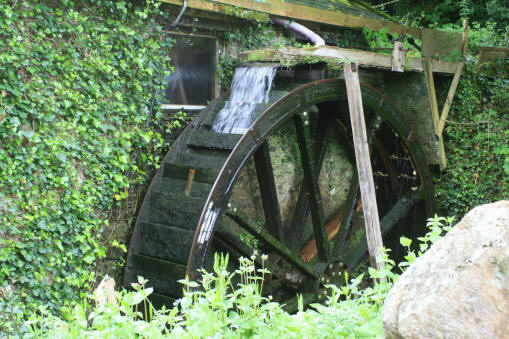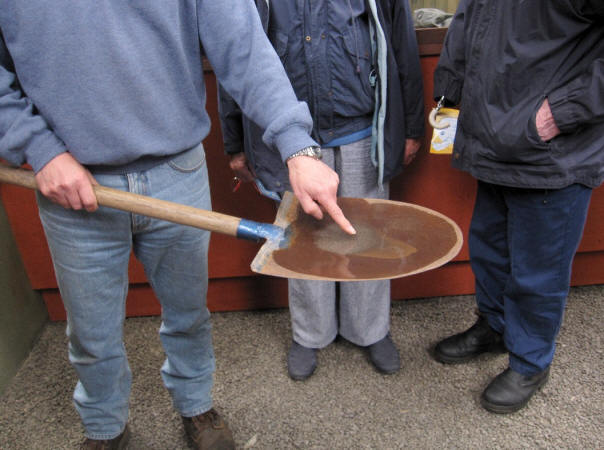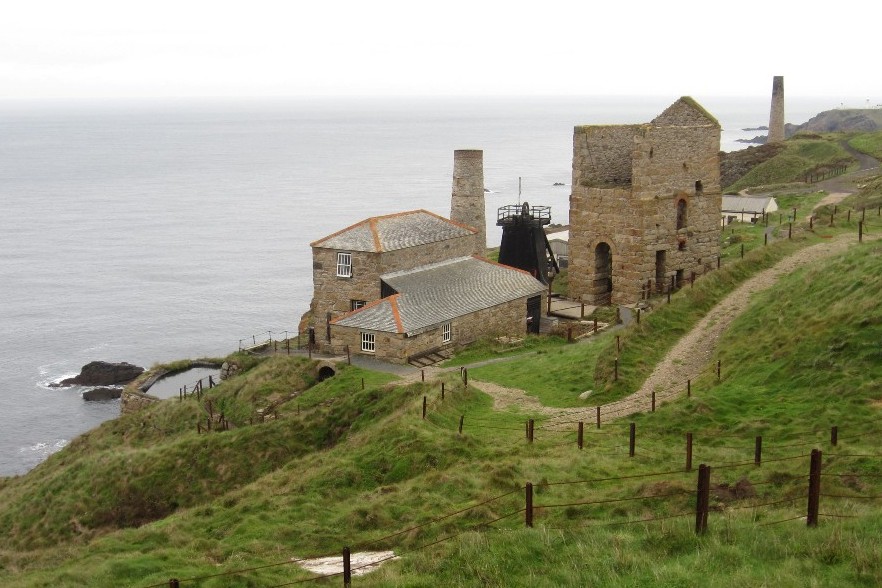|
   |
|
Page 5 |
Newsletter 114, Autumn 2016 © Hampshire Mills Group |
Cornwall Study Trip - Part 1
Sheila
Viner
Photos by Keith Andrews, Eleanor Yates, and the
author
|
|
Thursday 19 May saw an early morning start from
Hampshire for 11 HMG members as we set off for our
four day Cornwall Study Trip; Mick Edgeworth was to
have been ’twelfth man’ but, having sustained a back
injury, had to opt out. Several of us were picked
up from Eleanor Yates’s and Ruth Andrews’s houses in
Winchester where we were generously allowed to leave
our cars. Andy Fish once again was our driver and
he took us on an enjoyable route which followed the
coast road through Dorset, joining the A30 through
Devon.
We arrived at our first mill of the trip, in the
Tamar Valley on the National Trust estate of
Cotehele, just over the Devon border in Cornwall. A
pleasant, leg stretching walk from the car park
through woodland alongside the stream to the sturdy,
stone built Cotehele Mill gave us an energising bit
of exercise.
|
|
Inside we chatted with both John (in charge of the
weighing and bagging process) and Sally Newton who
became the miller in 2011; she had learned her
flour milling craft skills from Geoff Wallis at
Houghton Mill in Cambridgeshire. The previous
miller, Peter Langsford, was the last in his family
who had worked the mill for nearly a century,
retiring in the mid-1960s. In 2001 The National
Trust restored this mill to full working order
producing flour again.
|
 |
|
 |
We, having learned about Cotehele Mill’s history,
went and had a good look at the cast iron waterwheel
fed from a high, long, wooden launder; its 56
buckets each hold 9 gallons of water and, when
milling on their regular 2 days a week, normally
rotates at four revs per minute; at that speed it
can produce a maximum of 8.7hp/6.5kw as part of the
estate’s hydroelectric scheme. Originally the wheel
powered 2 sets of stones but only one set is used
now.
An amble further up the path led to the turbine hut
where there was a good, informative display and
sight of the plant, powered independently of the
mill from the Morden Stream, typically producing
3.7kw at 230 volts with a modest amount contributed
to the National Grid. On the path to the mill we
had passed through a cluster of stone buildings
which are now housing craftsmen producing pottery
and chairs formed from Cornish timber. It is also
possible to holiday there in self-contained mill
cottages.
|
|
 |
Hidden in a deep valley just a few miles away at
Veryan, our next mill was built in the 16th century
of stone replacing earlier wood constructions. We
found a warm welcome of home-baked scones, clotted
cream, and pots of tea were waiting for us.
Although no longer working, the little Melinsey Mill
still has all its grain milling equipment and a 16ft
iron waterwheel, cast in a Truro foundry in 1882;
artefacts from other local trades such as sawyer
and blacksmith were stored and on show, whilst a
willow man and other willowcraft creatures, made by
the owner, awaited the more adventurous among us
along a winding path beside the small river.
|
|
Our visit here was a delightful interlude in an
enchanting place and we reluctantly left, but, we
were wearying and so sped on to our accommodation
for the next 3 nights at the Travelodge just outside
Bodmin. Once installed, we only had a matter of
yards to trek for our evening meal as a licensed
restaurant had been built right next door.
The Blue Hills Tin Streams was our first destination
of day two and our introduction into Cornwall’s
mining industry and what a superb visit this was –
excellent displays, detailed demonstrations and
explanations covering every aspect of winning pure
tin. Mark Wills learned the art of tin stream
mining from his father as the Wills family were
tinners for generations and owned this site.
Originally the tin streamers worked the alluvial
sands and gravel on the beaches and valley floor,
becoming miners later, tunnelling into the hillsides
and sinking shafts deep below. The Blue Hills Sett
became, in 1810, a co-operative of the many smaller
mines giving employment to 100 men and their
families until it closed in 1897.
|
|
 |
 |
|
We watched how the tin was ‘teased’ out of crushed
raw ore with Mark’s deft movements panning on a
Cornish shovel. We then went outside to see the
water-powered stamps crushing the blocks of ore.
The alternated, calibrated movements of rise and
fall of the stamps were mesmerising.
Next we heard about the sorting of ores, then
washing and jigging – where the shovel is now
replaced by a sloping, grooved flat bed with water
played onto it and a mechanism to jiggle the
assorted ores into various collecting tanks. Women
played an important part in this industry carrying
out many of the sorting and washing tasks by hand;
they were called bal maidens. Another craft Mark
Wills has developed is in making fine, pure tin
jewellery which can be purchased in their shop. I
bought a peace dove pendant to wear as a tribute to
the families who had endured such tough working
lives.
Andy Fish’s superb driving skills, already
demonstrated on the increasingly narrow, and
tortuously steep winding lanes to and from the Blue
Hills Tin Streams, steered our valiant minibus to a
superb lunch of a freshly baked, traditional Cornish
pasty at Philps family bakery in Hayle (see front
cover).
Thus fortified we headed for the ‘mine under the
sea’ which is in the St Just Mining District, now
forming part of the Cornwall and West Devon Mining
World Heritage Site. One of the most ancient hard
rock tin and copper mining areas in Cornwall it is
now owned by the National Trust. The Levant Mine
and Beam Engine originally opened as a copper and
tin mine but, tin proved the more abundant of the
two elements. Surprisingly arsenic was a lucrative
but deadly by-product of tin ore that was used all
over the world as an insecticide.
Levant Mine first appeared on a
map in 1748 but the Levant Mining Company was not
formed until 1820; the next 110 years saw a number
of highs and lows in their fortunes. Tragedy had
struck the mine in 1919 when 31 miners plunged to
their deaths as a connecting rod on the man engine
(which was to have taken them down to the working
levels) broke. |
|
 |
|
The Levant whim engine is the only one of its kind
still working in situ: it is a beam engine, double
acting 24inch cylinder with a 4ft stroke, built by
Harveys of Hayle in 1840 and rebuilt by Hocking &
Loam in 1862 with a new cylinder and valve-gear
after an accident which caused the flywheel to be
thrown through the roof! This engine worked
continuously for 90 years at its task of raising ore
and only stopped when Levant was abandoned in 1930.
Levant Mine had subsea levels reaching out to
distances of up to 2 miles.
Whilst men endured highly dangerous and
uncomfortable work practices their womenfolk endured
backbreaking and arduous tasks in completing the
production of pure copper and tin. During the 19th
century women broke clods of ore, sorted and dressed
it during a long working day of 7am to 5pm
regardless of age, ranging from 9 to 90. The
majority of work was done in the open air and the
bal maidens were expected to work in almost all
weathers, only stopping if the water for dressing
the ore had frozen or had failed due to drought.
The coastline and geography combined with the
abandoned workings evoke feelings of raw beauty,
plus sadness and awe at the tenacity and endurance
of the Cornish in those times.
|
|
 |
Lamorna was our last destination of the day and we
arrived to see the little Kemyel Mill tucked against
a steep hillside amidst a profusion of tall, lush
garden plants and wild vegetation in an area once
famed for its colony of artists. The mill we viewed
was originally one of two and this was the upper
mill. It is owned by a lady whose family worked it
for 500 years and she still lives in the Mill House
although we were a little disappointed to find the
mill locked and not opened to view as we had
expected, but we made do with peering in its window
and wandering down to the turbine housed in the
Lower Mill and powered by the tail water from the
Grade 2 listed flour mill above.
|
 |

Tony Yoward was grateful for
the millstone left as a seat beside the Upper Mill
where he had a good view of the overshot waterwheel,
the shrouds of which were cast by Isaac Willie of
Helston in 1907. The wheel’s wooden buckets had
long since disintegrated. |
|
Historic England’s list entry tells us that this
particular building was probably erected in the 18th
century and comprises “Granite moorstone rubble
walls with some dressed moorstone. Grouted scantle
slate roof at rear, replaced with corrugated
asbestos at the front. Wheel has cast-iron hub and
segments, oak spokes. The machinery has been taken
out.” West Country mill historian, Martin Bodman,
states that Upper Mill has also been known as
Bossava Mill.
This visit to the beautiful and restful valley in
Lamorna gave a calming end to a day crammed with new
experiences and learning. This article concludes
the first of two – the second one, spilling the
beans on where we went next, will appear in the
Winter Newsletter.
A
record of the mines and other industries is
excellently presented in Industrial Archaeology of
Cornwall by A C Todd and Peter Laws, published by
David & Charles in 1972. It carries a dedication to
Rex Wailes for inspiring so many in the field of
industrial archaeology. |
|
|
